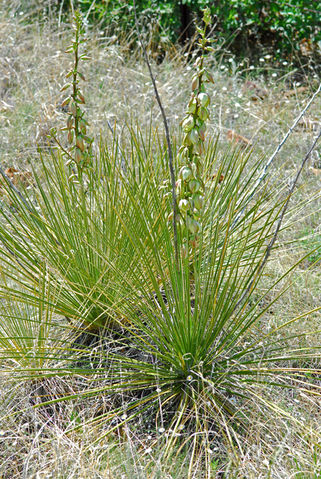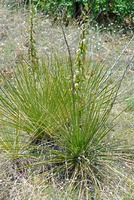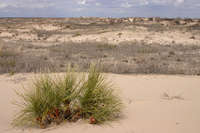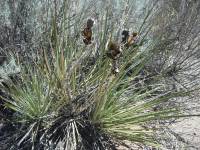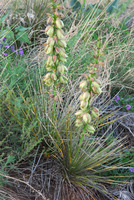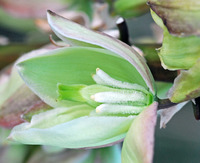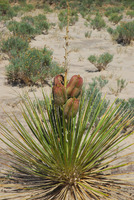Plants forming small to moderate colonies, acaulescent or caulescent and arborescent, occasionally branched; rosettes 1-15 per colony, usually small. Stems erect, to 0.4 m. Leaf blade linear to linear-lanceolate, concave to concavo-convex, widest near middle, 40-60 × 0.8-1.2 cm, rigid, margins entire, filiferous, white, apex blunt to acicular. Inflorescences racemose, occasionally paniculate proximally, arising within or just beyond rosettes, 5-10 dm; bracts erect, leaflike, 2-5 cm, reduced toward apex; peduncle scapelike, 0.2-0.5 m, less than 2.5 cm diam. Flowers pendent; tepals distinct, greenish white to white, elliptic, 5-5.3 × 2.6-3.5 cm, apex acute; filaments white, 1.7-1.9 cm; anthers yellow, 4 mm; pistil green, obovoid, 3-3.7 × 1.7 cm; style dark green, 10 mm; stigmas lobed. Fruits erect, capsular, dehiscent, cylindric to obovoid, rarely constricted, 5-8(-9) × 3-4.5(-5) cm, dehiscence septicidal. Seeds black, slightly glossy, thin, 9-12 × 8-9 mm.
Flowering spring. Prairies and waste areas in sandy or limestone soils; 500--2600 m; Alta.; Colo., Iowa, Kans., Mo., Mont., Neb., N.Mex., N.Dak., Okla., S.Dak., Tex., Wyo.
Yucca glauca has the most extensive distribution of any North American Yucca. Its inflorescences are primarily racemose, but some plants exhibit branched inflorescences and varietal names have been given them. Yucca glauca and Y. arkansana are very similar. The leaves of Y. glauca are uniform in size, rigid, linear or linear-lanceolate, and up to 1.2 cm wide. In Y. arkansana, the young leaves immediately surrounding the peduncle are distinctly shorter than the outer leaves of the rosette, and mature leaves are generally somewhat flexible, lanceolate, and up to 2.5 cm wide. K. H. Clary´s (1997) DNA evidence does not indicate as close a relationship as the morphological characters suggest. J. M. Webber (1953) believed that Y. glauca forms hybrids with Y. baileyi, Y. elata, Y. constricta, and Y. angustissima.
Common Name: soapweed yucca
Duration: Perennial
Nativity: Native
Lifeform: Succulent
General: Acaulescent or caulescent and arborescent plant from a woody caudex, with small rosettes; stems, when present, are erect, to 0.4 m, occasionally branched. Plants forming small to moderate colonies, with 1-15 rosettes per colony.
Leaves: Leaf blades long and narrow, widest near middle, somewhat flexible, crescent-shaped in cross section, 40-60 cm long by 1 cm wide, the margins white with occasional threads, and lacking teeth; leaf tips blunt or needle-tipped.
Flowers: Inflorescences racemose, occasionally paniculate toward the bottom, arising from within the rosettes, 50-100 cm tall, on a scapelike peduncle; flowers pendent, with white or greenish-white tepals.
Fruits: Capsules erect, dry, cylindric to obovoid, 5-8 cm long, splitting open at maturity to release seeds; seeds black, slightly glossy, thin, 9-12 mm.
Ecology: Found in grasslands and waste areas, in sandy or limestone soils, from 3,500-8,500 ft (1067-2591 m); flowers in the spring.
Distribution: The Great Plains of central N. Amer. from Alberta, MT, and ND, south to NM, n TX, OK.
Notes: Yucca glauca has the most extensive distribution of any North American Yucca. In the southwest it is primarily found east of the continental divide in northern New Mexico. Look for a smallish Yucca about half a meter tall, usually without a visible stem below the leaf rosette; a short flowering stalk, with most of the flowers well embedded within the rosette of leaves; dry, upright seed capsules that split open to release the seeds; and edges of the leaves that are smooth, with occasional thin white fibers. Y. baileyi is similar, and also grows in northern New Mexico, but has a more loosely flowered raceme with most of the flowers elevated above the leaves, and the distance from the bottom flower to the top flower is shorter, less than 0.5 m (that distance is 0.5 to 1 m in Y. glauca).
Ethnobotany: The roots were used to make soap, as well as a hair rinse used to hill head lice and stimulate hair growth.
Etymology: Yucca comes from Haitian word yuca, or manihot, because young inflorescences are sometimes roasted for food; glauca means covered with a blue or white waxy coating.
Synonyms: none
Editor: AHazelton 2015
Caudex very short, sometimes prostrate; lvs widely radiating, stiff, linear, to 8 dm, rarely over 1 cm wide, fibrous along the white margin, gradually tapering to a short slender spine; infl racemose or with a few short branches, rising to 1-2 m, its base not or scarcely elevated above the lvs; tep ovate to lanceolate, 4-5 cm, usually acute; fr prismatic, 5-7 cm; seeds 8-10 mm. Dry prairies and plains; w. Io. and Mo. to Mont., Wyo., Ariz., and Tex. June (Y. arkansana)
Gleason, Henry A. & Cronquist, Arthur J. 1991. Manual of vascular plants of northeastern United States and adjacent Canada. lxxv + 910 pp.
©The New York Botanical Garden. All rights reserved. Used by permission.


